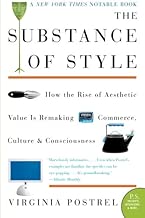
Sixteen years ago, Virginia Postrel was a well-known author in libertarian circles, in the 1990s she was the editor in chief of REASON. Not long after she stepped down from that post, though, she came out with a book on what was, to many of her admirers an unlikely subject, in The Substance of Style (New York, 2003).
The subject was the economics of the look and feel of things: ordinary things, not objects denominated "art." In part, it is about the artfulness of product design. But Postrel's interest in the aesthetics of ordinary life went beyond what one typically thinks of as product design issues -- it included everything from hair style to the aesthetic component of building and planning codes.
I will spend all this week posting about it, so this is the first post of a planned foursome.
The chief point of this book is that we are entering a distinctive age in human history, an "aesthetic age," one in which the look and feel of things is and will continue to be of unprecedented importance. Matters once regarded as frivolities are becoming central concerns with less and less apologetic knee bending to the curmudgeons who still complain that they are frivolities.
I was thinking of her book in recent days after channel-surfing to a television show about plastic surgery. For an actress who wants to continue to look as if she is 21, cosmetic surgery may be a profit-and-loss calculation. The appeal of such surgery, which has expanded, though, well beyond any narrow confines, raises the musical question: Why?
There is a nice quote in Postrel's book on p. 7 from "theorist Ellen Dissanayake [who] defines art broadly as 'making special.'" I had never heard the quote before, or heard of Ellen Dissanayake for that matter. I've looked her up since and have to say: her point is different from Postrel's. Postrel is trying to say we are n a new age. Dissanayake is discussing human nature, taking an "ethological" view of art, that is -- we make our things (and even perhaps our faces) special because that is the sort of animals we are.
Still, they are not contradictory insights.
To be continued.
Comments
Post a Comment